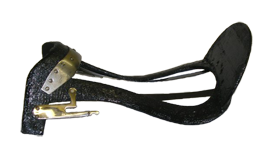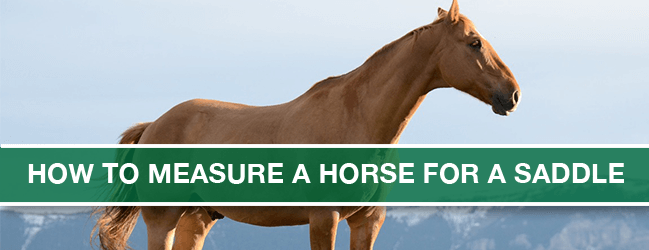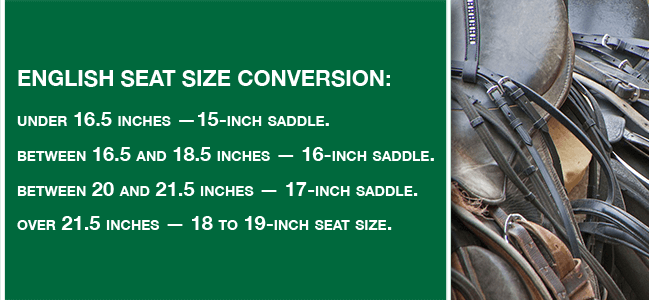Fitting a Horse Saddle

Learning to fit a saddle is one of the most important skills a horse owner can learn. A properly fitted saddle is comfortable for both you and your horse. If the saddle does not fit right, your horse can develop sores or even lameness.
The basics of saddle fitting are the same no matter what discipline you ride. For simplicity’s sake, we will discuss fitting a basic English all-purpose saddle and a Western stock seat saddle. You can apply the principles of fit for both saddles to specific types of English saddles, such as a jumping saddle, dressage saddle or cutback saddle, as well as other types of Western saddles.
The Importance of Saddle Fit
Saddles aren’t just for your comfort while riding — they act as the intermediary between the rider and horse. When the saddle fits properly, it conveys subtle signals of weight change to the horse through his back muscles and nerves. These signals help him understand and anticipate his rider’s commands.
Because the saddle panels sit on either side of the horse’s spine and on the muscles, proper fit is essential. If you have ever walked around in poorly fitting shoes, you know how painful it can be. The toes pinch, the heel slips, and before you know it, you’ve got a blister and aching feet. Think of how much worse it is for your horse if the saddle is too small, pinching along his shoulder muscles and back. A saddle that’s too big will slip around, causing painful back sores.
A well-made saddle in good condition should last for many years, even decades. You should check saddle fit, however, annually, but ideally twice a year. A horse exercised consistently will maintain the same overall shape, but a horse worked inconsistently or on rest for a month or two may change shape, requiring some adaptations to the saddle or saddle pad for best saddle fit.
Older horses’ body conditions can also change rapidly, requiring adjustments to the saddle. Saddles can also stretch, shift or change over time. Stitching can unravel, and padding can flatten or become stiff.
Next to the purchase price of your horse, your saddle is the second most expensive investment you will make. Take your time to really check the fit of the saddle before investing in one. Learning how to properly fit a saddle is a key part of being a responsible and successful rider.
If your saddle does not fit well, or your horse’s body changes and your saddle no longer fits, do your best to adjust the saddle. You can borrow a friend’s saddle or trade your old one in for a new one at many tack shops around the country. Whatever you do, don’t skimp on fit. Not only will a properly fitted saddle feel better, but you will ride better, too.
How Saddles Are Constructed: Parts of a Saddle
Saddles are constructed around a wooden or plastic tree. The tree forms a skeleton around which sheets of leather or manmade fabric are placed, shaped and molded to form the saddle itself. The tree is shaped like the letter “T” with the bars of the tree fitting over the horse’s withers, or shoulders, and the long stem of the T running down along either side of the horse’s spine.
Horses, like people, come in different shapes and sizes. Some horses have high or narrow withers; others are very wide with hardly any wither at all. Each shape requires a slightly different tree. Saddle trees are made in specific sizes to fit different shapes.
After the tree is formed, layers of thin leather are glued over the tree and cut into shape. Western trees are formed with a saddle horn and wider bars. English trees lack the horn and tend to have narrower bars.
Once the leather is placed and shaped over the seat, padding may be added. English saddles have panels stuffed with foam or wool. Knee rolls — suede or leather patches stuffed with wool or foam — may be added to the flap that extends down the horses side behind the shoulder. Knee rolls on English saddles help to keep the rider’s leg in position.
On a Western saddle, leather is added to the seat to form the fender, which fits between the rider’s leg and the horse like filling in a sandwich. The skirt, various straps and keepers are also added.
All saddles require a girth (English) or cinch (Western), which is the strap that runs under the horse’s belly and holds the saddle in place. Girths are interchangeable, and you can unbuckle them and swap them out for another style or type if you like.
Both Western and English saddles also require a pad or blanket under the saddle to protect the horse’s back against rubs and to help keep your saddle clean. Western blankets are square or rectangular and made of wool or another thick, absorbable fabric. English saddle pads are shaped to the saddle and made of acrylic, wool fleece or cotton. White tends to be the preferred color for English saddle pads.
How to Measure a Horse for a Saddle
Measuring a horse for a saddle is really an art. There are steps you can take, but a master saddler has years of experience eyeing horses and choosing saddles that fit. Some tack shops have employees who will actually come to your barn and help you fit the saddle. If such a service is available, take advantage of it. Nothing beats experience when it comes to horsemanship.
Even if you have the luxury of an expert to help you fit your saddle, it’s important to learn how to measure a horse for a saddle. To narrow down your choices, you will still need some idea of the type, size and construction of the saddle you need.
To measure for both Western and English saddles, evaluate your horse’s conformation. Cross-tie your horse or have a helper stand him square outside. Take a step back and scan your horse from the side, back and front. Does your horse have high withers or normal withers? A long or short back? A swap, dip or another anatomical difference that needs compensation?
Choose the tree type first:
- Narrow — Very high or narrow withered horses may need extra padding behind the saddle bars. This shoulder bridge pad helps the saddle fit better.
- Medium — A horse with average withers usually takes a medium or regular tree.
- Wide — Horses with a block build or flat withers take a wide tree.
- Extra Wide — Draft horses, draft crosses or horses built “big and wide” need an extra-wide tree.
- Flexible — Horses with big, well-developed shoulder muscles can be hard to fit. These horses may do well with a flexible tree.
Now determine how well the saddle fits on the horse. To test saddle fit, slide the saddle on without a pad. While you shouldn’t ride without a pad or blanket, you test saddle fit without one.
English Saddles: Wither Test
Now, you will need to check the tree to see how well it fits on the withers:
- Slide the saddle on from the withers to the horse’s hindquarters.
- Let the saddle rest naturally on the horses back without buckling the girth.
- Slip your fingers in the area where the saddle tree clears the withers and take note of the space.
If your saddle is padded with synthetic material, or you are trying a used saddle, you should be able to slide two or three fingers’ width between the saddle and withers. If it’s a new, wool-stuffed saddle, there can be a little more room between the saddle and withers. As you ride, your weight compresses the wool and closes the gap.
English Saddles: Balance and Level Test
English saddles should sit fairly level along the topline or horse’s back. General, all-purpose and jumping saddles should form a slight U-shape along the back. The dip in the saddle seat should sit balanced on the back.
General or all-purpose English saddles have pommels (front) and cantles (back) about the same size. The cantle may be slightly higher. They should sit evenly on the back.
Walk around your horse and note if the saddle looks even on both sides. It should appear balanced and centered on the horse’s back.
Western Saddles: Wither Test
On a Western saddle, you can conduct the same wither test as on an English saddle. Slide the saddle into place, and then slip your fingers between the gullet and the horse’s withers.
- A good fit — Two to three fingers’ width is just about right.
- Too narrow — If you can fit your whole hand in between the withers and saddle gullet, the tree is too narrow.
- Too wide — If the gullet touches your horse’s topline, or you can barely squeeze a finger in, the tree is too wide.
Western Saddles: Balance and Level Test
As with an English saddle, you should also examine a Western saddle for proper balance. After placing the saddle on your horse’s back, walk around and look at how it fits.
- Does the saddle look level? If not, try repositioning it or using shims. You can also try different rigging positions.
- Does the saddle look too high in front? The tree may be too narrow.
- Does the saddle look as if it’s slumping forward or sagging in the front? The tree may be too wide.
Can You Use Pads to Correct Poor Saddle Fit?
You can use pads to correct poor saddle fit, but pads shouldn’t be your only line of defense. Pads can be a great help with an aging horse whose saddle fit tends to change rapidly.
You can use foam rubber inserts and other pads for horses developing sway backs, or aging horses whose shape is changing. Western riders can try changing the rigging to adjust fit.
Saddle Fit for the Rider
Saddle fitting is complicated because you have not one, but two living beings to fit: a horse and rider. So far, we have discussed fitting the saddle to the horse. Let’s take a look at saddle fit for the rider.
You determine correct rider saddle fit by the saddle’s seat size and flap length. The saddle seat has to be in proportion to the horse as well as the rider.
Too short a seat makes the saddle hit at an odd spot on the back, which can put the rider’s center of balance too far forward. A too-long seat can interfere with the hindquarter muscles and compromise your horse’s performance. That is why both the rider and horse must be well matched in size and shape, as well as saddle to horse and rider. It is a tricky business, which is part of the art of horsemanship.
To estimate your seat size, start by measuring your thighbone.
- Wear your normal riding clothes.
- Sit in a straight-back chair without arms.
- Measure from the knee cap to the back of the buttocks.
- Write down the number in inches.
Now, convert the inches into English seat sizes.
- Under 16.5 inches — You probably need a 15-inch seat size in an English saddle.
- Between 16.5 and 18.5 inches — Look for a 16-inch saddle.
- Between 20 and 21.5 inches — Try a 17-inch saddle.
- Over 21.5 inches — Try an 18- or 19-inch seat size.
If you ride Western, you can use the same measurements with a slight adjustment. Western saddle seat sizes tend to run about one to two inches smaller than English sizes. If you look at the numbers above, and your thighbone is 20 inches, you should try a 17-inch English saddle or 15-inch Western saddle seat size.
When in doubt, size up rather than down in a saddle size. If you are between numbers, go up a size, too.
English Saddle Fit for the Rider
To measure the saddle seat size for English saddles:
- Take a tape measure and place one end against the nail or button on the left front panel of the saddle near the top.
- Bring your tape measure to the high point on the middle of the cantle.
This measurement is the seat size.
English seat sizes for all-purpose saddles are generally noted as follows:
- Seat sizes 15 to 17 inches — Best for junior riders or smaller adults
- Seat sizes 17 and 17.5 inches — Most popular size for average height and weight adults
- Seat sizes 18 and 19 inches — Best for larger adult riders or tall riders

When you are sitting in a saddle that is too small, your buttocks will hit the cantle, or your crotch will hit the pommel. Sitting centered during a sitting trot or canter is almost impossible because you will be halfway out of the saddle. If the saddle is too big, you will find yourself sliding or wiggling around often to find the center of balance.
If you are testing a saddle, drop your stirrups and ride the sitting trot in an English saddle. If you can stay centered and balanced without feeling as if you’re swimming in the saddle or pinched, it’s probably within a good range.
Padding and saddle construction can make a seat size feel different, even if the measurement is identical. Many European brands feel different from American or South American-constructed saddles, such as Argentine English saddles.
One way to get a feel for different saddles is to ride different horses in lessons, noting which saddles feel great and which ones are uncomfortable. You will soon develop a preference for brands, styles and even leather types on English saddles once you have had a chance to try them out.
Western Seat Sizes for the Rider
Western saddles are generally sized smaller for riders than English saddles. If you know your seat size in an English saddle, a good rule of thumb is to choose a Western saddle with a seat size two inches smaller than your typical English saddle size.
Sit in the Western saddle. There should be about four inches between your body and the swell of the saddle. Anything less than that may mean a too-small saddle, and a bigger gap means the saddle may be on the large size. Larger may be more comfortable for you.
Western riders with longer legs should choose a larger-size saddle. The fenders are scaled according to the seat size, and a larger saddle will come with longer fenders, which take up your leg better.
New Saddle Technology
Science and technology have brought about some amazing advances in all areas of life, and saddles are no different. Saddles may have been around for hundreds of years, but advances in modern technology are changing how we make and fit them.
Some English saddles come with interchangeable gullets and adjustable trees. These saddles are built around a fiberglass or plastic tree instead of a traditional poplar or birch saddle tree. A special wrench, similar to an Allen wrench, is used to adjust the tree to fit the horse. These saddles are great for trainers or training barns where the same saddle must be used on many horses.
Another advancement among both Western and English saddles is the use of manmade fabrics to cover the saddle. Leather is durable and comfortable, a time-honored material for both English and Western saddles. However, manmade fibers are easier to clean and can withstand rain and snow a lot better than leather. They can be easier to break in for both horse and rider, easier to wipe clean after a trail ride and just as durable as leather.
Try riding in a synthetic saddle to see how you like it. They are not for everyone, but they can be great for competitive-trail or pleasure riders who don’t want to fuss with leather cleaning and conditioning.
Properly Fitted Saddles Make Riding Easier and More Comfortable
No matter your riding discipline, a properly fitted saddle makes your horse more comfortable. It enhances his natural gait or stride, making it easier for him to accomplish whatever you ask him to do.
Not only will your horse be more at ease, you will be too, when your saddle fits well. Like a comfortable pair of sneakers, a well broken in and cared-for saddle eases you into your ride and makes hours in the saddle a pleasure. Take your time to find and fit a saddle for both you and your horse. You will both be glad you did.
Keep Your Horse Fit and Healthy
Keeping your horse healthy and in overall good condition is part of being a good rider and owner. It will also help your saddle fit consistently as your horse maintains his weight and body condition.
Kauffman’s® all-natural equine nutrition products will help your horse put on or keep his weight, maintain a glossy coat and healthy hooves, and build strong muscles. Find our products at your favorite tack and feed store or view our website for detailed information on our line of Kauffman’s® Integri-Hoof and Kauffman’s® Animal Health products for competition and pleasure horses. For more equine care tips and to receive special deals, sign up for our e-newsletter today.




